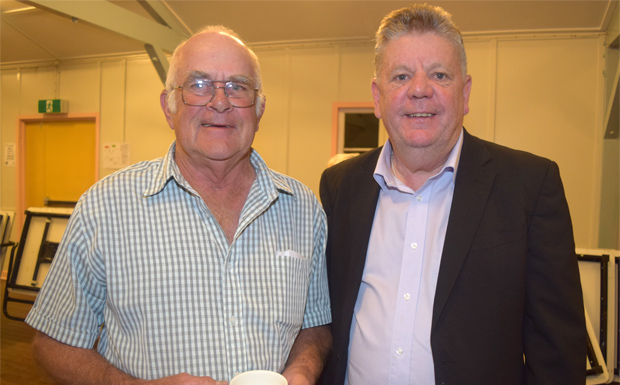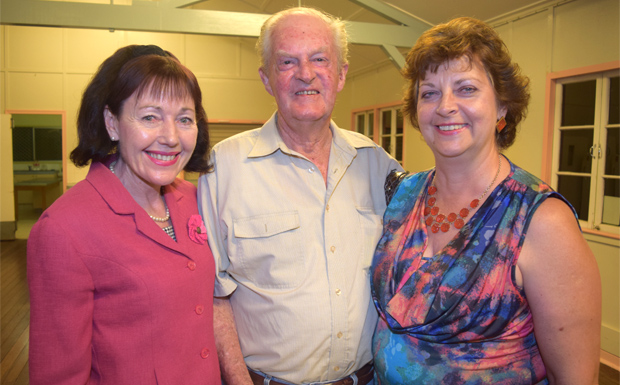
October 20, 2014
The South Burnett Regional Council could put an end to quarterly rates bills in 2015.
The suggestion was made by Mayor Wayne Kratzmann, who was speaking at a public community consultation meeting held at Murgon Town Hall on Monday night attended by about 40 residents.
The meeting is the first in a series the Council plans to hold around the region over the next few months in an effort to improve communications.
It was called to give interested residents an update on the Council’s operations, as well as answer questions on any issues of local concern.
* * *
Responding to a question from former Murgon Shire councillor Earl Pratt about whether there was any possibility of returning to half-yearly rates, Mayor Kratzmann said the issue will be “workshopped” by councillors next week.
The Mayor said Council had introduced quarterly rates after he received representations from the region’s business community that smaller, more frequent rates notices would help them budget better.
But after more than two years of quarterly billing, he thought a return to twice yearly or even annual billing might be easier for many people.
The Mayor said one option he wanted to discuss with fellow councillors was an annual bill that allowed ratepayers to choose their own repayment schedule.
Under the system he had in mind, residents would still be able to claim discounts if they paid early, and would be encouraged to do so.
But they would not be liable for any penalty interest charges until a full six to 12 months after their rates bill was issued, depending on whether the Council returned to six or 12 monthly billing.
This would give ratepayers more flexibility in deciding how to pay their bill and also relieve them from receiving invoices every quarter, he said.
The Mayor stressed no decision had been made but he thought ongoing pressure to reduce Council costs would play a role in any move to return to longer rate billing periods.
* * *
The Mayor also delivered a withering blast to critics who have recently claimed Council costs were out of control, rates were higher than average and Council staff numbers were excessive.
During his presentation on the Council’s operations, the Mayor brought up a comparison of rates on two similar urban properties in Murgon and Gympie.
Rate bills which allowed the comparison had been supplied by Murgon retailer Mark Smith, who owns properties in both towns.
They showed that rates on a Gympie property with access to the same facilities as the Murgon property (eg. library, swimming pool, visitor information centre, public hall, water, sewerage, garbage collection etc) were almost $500 higher per year.
As well, the 5 per cent early payment discount offered to Gympie residents was only half the 10 per cent offered in the South Burnett.
Responding to a question from the floor, Mayor Kratzmann also said a rumour that rates on the coast were cheaper was untrue; coastal rates were generally the same or higher than South Burnett rates.
“Where people often make a mistake is that in many parts of Brisbane and the coast, water and sewerage charges are billed separately by utility companies and don’t appear on the local Council’s rates notice,” Mayor Kratzmann said.
“When you add these in, the total picture looks a lot different.”
* * *
The Mayor said claims Council staff numbers were too high were also unfounded.
“We currently have around 310 full-time equivalent staff on our payroll,” he said.
“We have reduced staff by about 12 per cent through natural attrition, and our current workforce is equal to roughly one staff member for every 100 residents.
“The State average is 1.5 to 2 staff for every 100 residents, and if we had that then we’d have more than 500 staff on the books,” he said.
* * *
Finally, responding to criticisms that Councillors “did what they liked”, the Mayor pointed out the Council is compelled by law to pay the State Government almost $250,000 every year just to have its accounts audited and that annual audits “took months” to carry out.
“People who say that we do what we like don’t know what they’re talking about,” the Mayor said.
“We work in one of the most heavily over-regulated environments in existence.”
* * *
Regarding rates in general, the Mayor agreed that rates had risen significantly since amalgamation but said this was a State-wide issue that affected all Councils, not just the South Burnett.
He said one of the main reasons for rate rises was that when Councils were amalgamated, the State Government also updated accounting rules to force all Councils to fully fund depreciation of their assets.
This was something most councils had done only partially (or not at all) prior to the mergers.
The Mayor said most of the region’s “big ticket” infrastructure items such as water and sewerage plants had been built between 1950 and 1965.
“Next year all of these will be between 50 and 65 years old,” he said.
“The old councils used to patch these up rather than set aside money to replace them. But now they’re all nearing the end of their working lives and they will have to be completely replaced.”
Another strain on council budgets was that Federal and State funding for local government had been greatly reduced as both other levels of government struggled with their own debt issues.
“Prior to amalgamation, our old councils used to raise 59 per cent of their running costs from rates and received the other 41 per cent in grants,” Mayor Kratzmann said.
“Now – six years later – we have to raise 74 per cent from rates and only receive 26 per cent in grants.”
The Mayor went on to say that he personally thought rural rates were too high because they were tied more closely to property valuations than urban rates and those valuations could be affected by one-off sales of farmlands at higher than usual prices.
“This is an issue that will take some years to work through,” the Mayor said.
* * *
The Mayor also pointed out that roughly 25 per cent of the South Burnett’s ratepayers were pensioners.
This is above the State average and was an issue that weighed heavily on all Councillors, he said.
“We held this year’s rate rise down to 2.75 per cent and next year’s will be the same,” he said.
“This is the lowest rate rise since amalgamation and it took eight separate drafts of the Budget to do it, but we did it because we know many people are doing it tough.
“We need more population to ease budget pressures, and we’re looking at ways to achieve that.”
The Mayor also thought the Federal Government should do more to assist pensioners.
He said most pensioners had paid taxes to the Federal Government all their lives, but it was left to councils to give pensioner rate discounts and any other assistance they could.
“This should be something the Federal Government should do,” he said.
The meeting concluded with a presentation of historian Liz Caffery’s “Poppy Trail”, followed by tea, coffee and cakes as guests mingled with the Mayor and fellow councillors to raise individual questions.
























